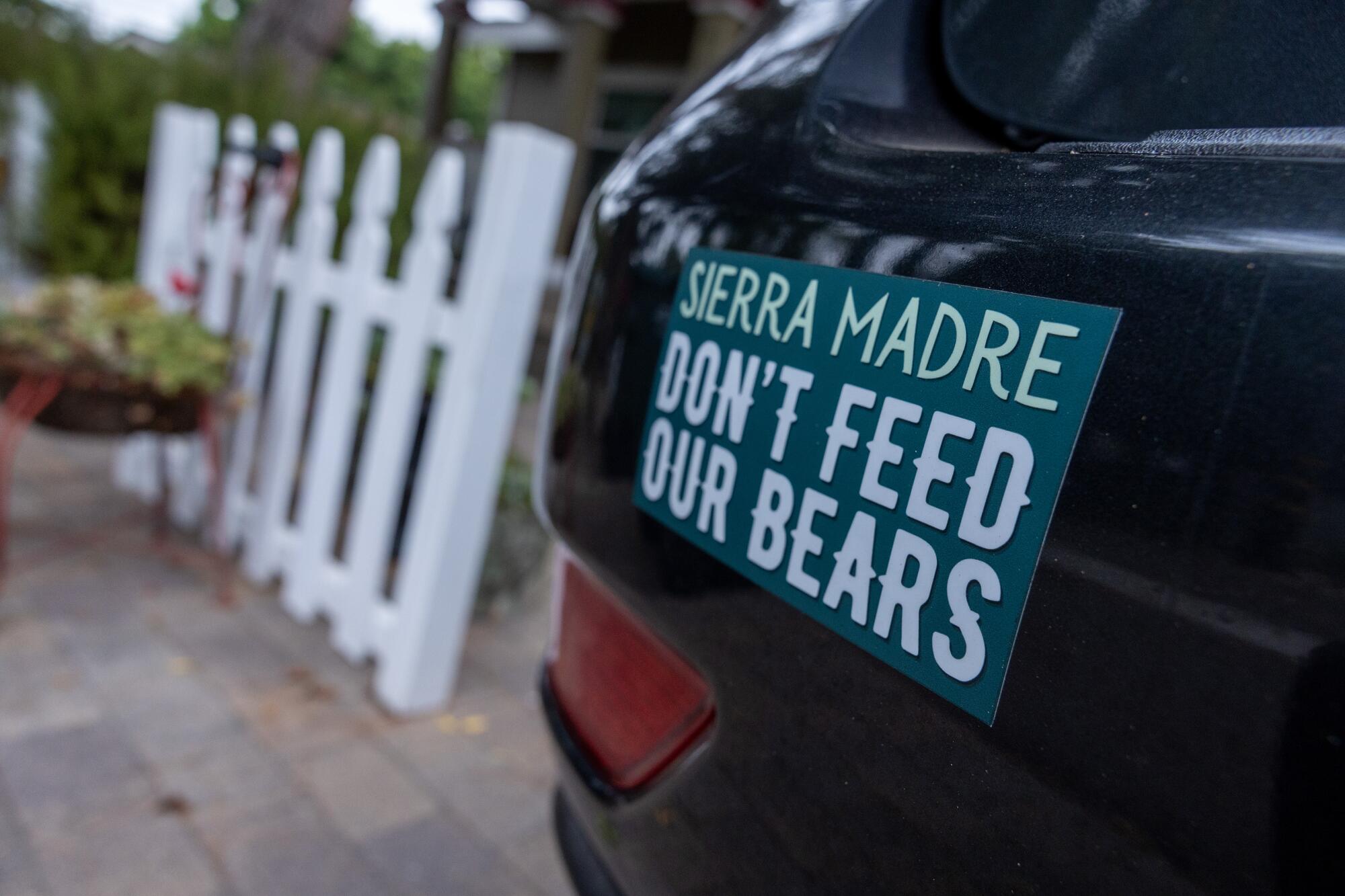-
How to Watch New York Liberty vs Connecticut Sun: Live Stream WNBA, TV Channel - 8 mins ago
-
LAPD IDs man suspected of shooting driver who slammed into crowd - 36 mins ago
-
New York Knicks Star Reacts to Terry McLaurin Trade Rumors - 43 mins ago
-
A Bid to Undo a Colonial-Era Wrong Touches a People’s Old Wounds - 44 mins ago
-
Kevin O’Leary Rips Donald Trump for ‘Whacking’ Labor Bureau Chief - about 1 hour ago
-
Trump Fires BLS Commissioner, Claiming Weak Jobs Numbers Were ‘Rigged’ - about 1 hour ago
-
Cowboys Make Roster Announcement After Injury-Filled Week - 2 hours ago
-
Jeannie Seely, Who Pushed Boundaries and Broke Hearts at the Grand Ole Opry, Dies at 85 - 2 hours ago
-
How to Watch Tigres UANL vs San Diego FC: Live Stream Leagues Cup, TV Channel - 2 hours ago
-
Uptick in stingray injuries in Seal Beach; How you can avoid — and soothe — the sting - 3 hours ago
Bear trouble in Sierra Madre: After the Eaton fire, home invasions rise sharply
Police and wildlife officials were bombarded for weeks with reports of bears barging into homes in Sierra Madre, smashing windows and slashing screen doors.
So the California Department of Fish and Wildlife decided to kill the 300-pound female bear believed to be the culprit. State biologists set up a trap and the bear soon lumbered into it.
The bear was tranquilized and later shot and killed last month after wildlife personnel confirmed they had the right bear — a call based on a distinctive patch of fur on her back. The bear also had blood on her paws, a sign she had broken glass.
Break-ins dropped off after the bear was put down, but Sierra Madre officials say their ursine troubles are far from resolved.

A bear believed to be behind a spike in home break-ins in Sierra Madre walks along a street. Wildlife officials say a distinctive patch of fur on the bear’s back helped them identify it.
Sierra Madre, Claremont, Monrovia and other communities nestled just below the San Gabriel Mountains are a hot spot for human-bear conflict reports. Some say the Eaton fire has worsened the situation, driving bears whose habitat was charred into neighborhoods to seek food and water.
“With the fires, the weather and the dryness and heat, they’re coming down,” said Lt. Charles Kamchamnan of the Sierra Madre Police Department.
Local representatives for years have blasted the Fish and Wildlife Department for mismanaging black bears and demanded the agency mitigate what they describe as a public safety threat. But they say nothing has changed.
In fact, the state cut all of its human–wildlife conflict specialists in Southern California after funding ran dry last year. Local leaders have started discussing what steps they can take on their own.
“We need to figure this out before someone gets seriously maimed or killed, and before people start taking measures into their own hands and go bear hunting,” said Assemblymember John Harabedian (D-Pasadena). “We don’t want that. And I’ll tell you, people are at a tipping point.”
Sierra Madre spans just three square miles nestled into the wrinkled hills, with some homes perched right in the mountains. Prominent trails, including one to Mt. Wilson, allow wild animals to amble down directly into the community of 11,000.
What tack to take with the bears remains a matter of disagreement. Some are calling for more forceful intervention, while others argue that people need to be better at securing trash and reducing other bear attractants.

A bumper sticker on Michelle Tremblay’s car in Sierra Madre. Tremblay is the president of Bear Lovers of Sierra Madre, a nonprofit that seeks to keeps bears and people safe through education.
(Brian van der Brug / Los Angeles Times)
How it started, how it’s going
California is home to roughly 60,000 black bears, the highest population estimate for anywhere in the contiguous U.S. But black bears are a surprisingly recent phenomenon in the San Gabriel and San Bernardino mountains.
In 1933, 27 bears “whose antics got them kicked out” of Yosemite National Park were set loose in Southern California, The Times reported. Eleven furry, four-legged transplants were released near Crystal Lake northeast of Sierra Madre, while six were dispatched near Big Bear Lake and 10 in Santa Ana Canyon.
People with deep local roots say bear conflict has only become an issue in recent years.

A bear-resistant trash can in Sierra Madre. “There’s a lot of support for bears in the city,” Mayor Robert Parkhurst said. “There’s a lot of interest and willingness to live with bears, to coexist with them, but we’ve begun to see some increase in intrusions.”
(Brian van der Brug / Los Angeles Times)
Sierra Madre City Councilman Gene Goss said bear sightings were a rarity when he moved to the area in 1996. Harabedian said there’s been an “exponential rise” in bear activity in San Gabriel Valley cities over just the past decade.
This June, Sierra Madre saw a surge in bears entering homes. There were 41 intrusions that month — a vast leap from the one recorded in 2023, the year police began tracking bear incidents in earnest, according to a presentation at a July 8 City Council meeting by Sierra Madre Police Chief Gustavo Barrientos. There were 37 break-ins throughout all of last year, with 13 in June.
Residents of the city’s canyon area have taken to affixing wood pieces and bars over their windows to prevent bears from tearing through, Mayor Pro Tem Kristine Lowe said at the special meeting. Her in-laws have installed metal sheet grates over theirs, marking a “huge cost” for mitigation. City Atty. Aleks Giragosian said last year that local bears had learned to open doors, “like ‘Jurassic Park.’”
Black bear attacks are rare, but officials expressed fears that someone could get hurt as bear run-ins increase.
Goss recounted an instance two years ago when his son, shooting hoops in the yard, saw a bear charging him. It had been spooked by neighbors who were making noise to shoo it away. Goss’ son moved out of the way, and it ended up in another property, where young children are often playing.
“What do panicked animals do if you block their path or if you move suddenly?” he said. “There’s just so many things here that potentially could go wrong.”
In 31 years on the Sierra Madre police force, Lt. Kamchamnan recalls three incidents where bears assaulted people, including a hiker who was attacked by two bears. In another instance, a bear maimed the hand of a man living in the Chantry Flat area of the Angeles National Forest. The unhoused man told Kamchamnan he was trying to put a leash on the hefty creature.
Sometimes local police will scare bears out of residents’ homes with air horns or projectiles that release an irritant akin to pepper spray, but they are legally limited in what they can do. Fish and Wildlife is primarily responsible for managing the hulking mammals, including making the call to move or euthanize them.
“Somebody up there is taking huge risks by not taking this problem more seriously,” Goss said of state wildlife officials at the July meeting.
Peter Tira, a spokesperson for CDFW, said his agency for years has worked with local officials to address the city’s bear issues — and will continue to do so.
“We want healthy bear populations that stay wild and don’t come into conflict with people,” he said. “So we’re all working towards the same goal.”
But he said the buck doesn’t stop with the agency.
“The solution to human-bear conflicts rests with individuals and the community,” Tira said, adding that the key is preventing access to trash, pet food, fruit trees — any food fit for a bear’s palate. “It’s really not super complicated.”
Simmering tension and funding trouble
The Sierra Madre City Council passed a resolution in 2023 demanding that the state wildlife agency correct what it called its mismanagement of local bears.
A year later, the Los Angeles County Supervisors called on the agency to create a regional approach to addressing human-bear interactions to protect Sierra Madre and nearby areas and to hire more human-wildlife conflict specialists. Instead, state officials let go of all but one of its 13 conflict positions after one-time funding expired, citing budget cuts.
A statewide program remains that allows people to report incidents that “go right to our biologist, right to the closest person who can deal with those issues,” Tira said.
Some Sierra Madre officials pointed to the uptick in bear intrusions this year as a possible result of losing the conflict specialist who served the city. They’re not counting on a more robustly staffed state wildlife agency anytime soon.
Sierra Madre Mayor Robert Parkhurst has scheduled an Aug. 8 workshop for mayors along the foothills to discuss what can be done. There have been early-stage talks about creating an intergovernmental authority and pooling money from various cities in the region to fund their own local wildlife conflict specialists, Goss said.
However, like the state, many cities are facing strained budgets. And creating such an authority would take time, testing the patience of residents who are demanding action now.
Harabedian, one-time Sierra Madre mayor, doesn’t see local authorities winning the day on bears. He introduced legislation this year that would have required CDFW to establish measurable performance goals for reducing bear encounters in the San Gabriel Valley, as well as tag and track any bears that entered neighborhoods in the region, among other things.
CDFW estimated that the effort would cost $3.7 million for the 2026-27 fiscal year and $2.9 million for the following fiscal year and beyond. The bill died in the assembly’s appropriations committee, but Harabedian vowed to bring it back in some form.
State wildlife officials “had a long time to come up with the answers, and they haven’t come up with it,” he said. “So I think that we need to have a real impetus and real fire under the department.”
The hand that feeds
Humans have moved deeper into wildlands where bears live, while the ursids have similarly expanded into areas where they were absent or scarce. Conflict has increased along with spatial overlap, with most incidents involving “the intersection of black bears and attractants, such as food, garbage and livestock,” according to a state black bear management plan.

Sierra Madre resident Michelle Tremblay opens her bear-resistant, locking trash can. She said recent surveys suggest roughly 50% of residents aren’t latching them.
(Brian van der Brug / Los Angeles Times)
During the height of the recent surge in break-ins in Sierra Madre, a man was leaving out an entire rotisserie chicken on his lawn to feed ravens, said Michelle Tremblay, president of Bear Lovers of Sierra Madre, a nonprofit that seeks to keep bears and people safe through education. Others in the community have left out water to help coyotes, birds and “any poor wildlife” left high and dry by the Eaton fire, she said.
Sierra Madre has special locking trash cans to deter bears, but Tremblay says recent surveys she’s conducted suggest roughly half of the residents don’t latch them.
Tremblay, who is enthralled by bears, is torn by how to deal with bears that, say, ventured into a home but haven’t harmed a soul. She hopes bear experts will come up with a nonlethal solution.
“They’re a very important part of the ecosystem and the natural world, and it breaks my heart to see that a healthy bear would be put down because now they’re categorized as a conflict bear,” Tremblay said. “But I also realize we don’t want to wait until somebody is hurt.”
Sometime in May while on a walk, Tremblay spotted a sizable bear on a hillside — one she thinks could be the one killed by authorities last month. It peered down at her. She sounded a bear horn, but it didn’t respond. Then she yelled and it walked away.
She didn’t take a photo; she never snaps photos of bears.
“If I see a bear, I will just soak in that 15 or 20 seconds and marvel at how beautiful they are,” she said.
Then, if the bear is in her yard, she will try to scare it away.
Source link




















